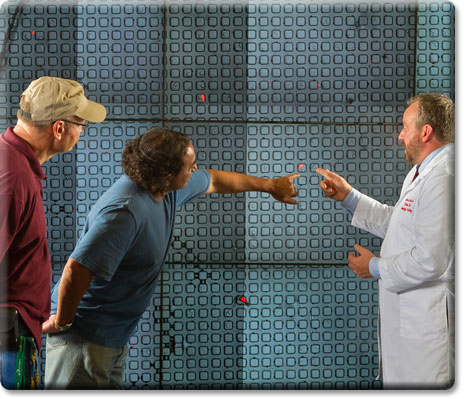
Integrated Nanosystems Research Facility
Micropallet Arrays
 Dr. Edward Nelson (far right) uses the Hiperwall to magnify his micropallet arrays; he discusses results with INRF’s Jake Hes and Mo Kebaili.
Dr. Edward Nelson (far right) uses the Hiperwall to magnify his micropallet arrays; he discusses results with INRF’s Jake Hes and Mo Kebaili.
Tumor immunologist and physician Dr. Edward Nelson uses micropallet arrays designed by engineers G.P. Li and Mark Bachman to characterize cell populations in tumors. The device actually measures about 1 inch by ½ inch, but it contains 40,0000 – 50,000 individual plastic blocks just large enough for single cells obtained from a biopsy to land on and stick to. Each type of cell in the tumor expresses different types of molecules on its surface. By adding antibodies, each of which naturally attaches in different combinations to these expressed molecules, Nelson can identify what type of cells they are – endothelial progenitor cells, which make blood vessels; cancer stem cells, which are thought to be the origin of tumors; or subsets of the tumor cells themselves. His team developed a methodology to connect each antibody to a specific colored nanocrystal, allowing easier identification of the tumor cells after the antibodies attach. Monitoring individual cells can also lead to improved healing techniques by replicating biological processes with pharmaceuticals. One day, we might even send into the body tiny nanoparticle-protected cages containing drugs that would only release their contents when they arrive at the right cellular “address.”
“The recurrent theme here is to make everything work better,” Nelson says. “If we’re smart about it we can reduce the toxicity and enhance the efficacy of drugs.



